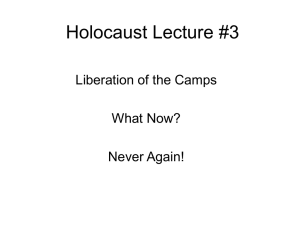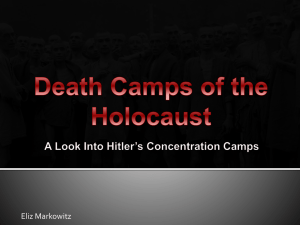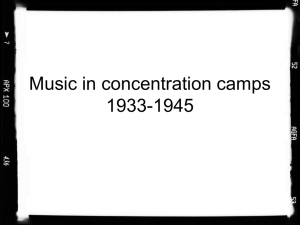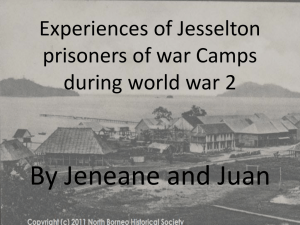WWII Build Up lesson 8 - Death Marches and Liberation
advertisement
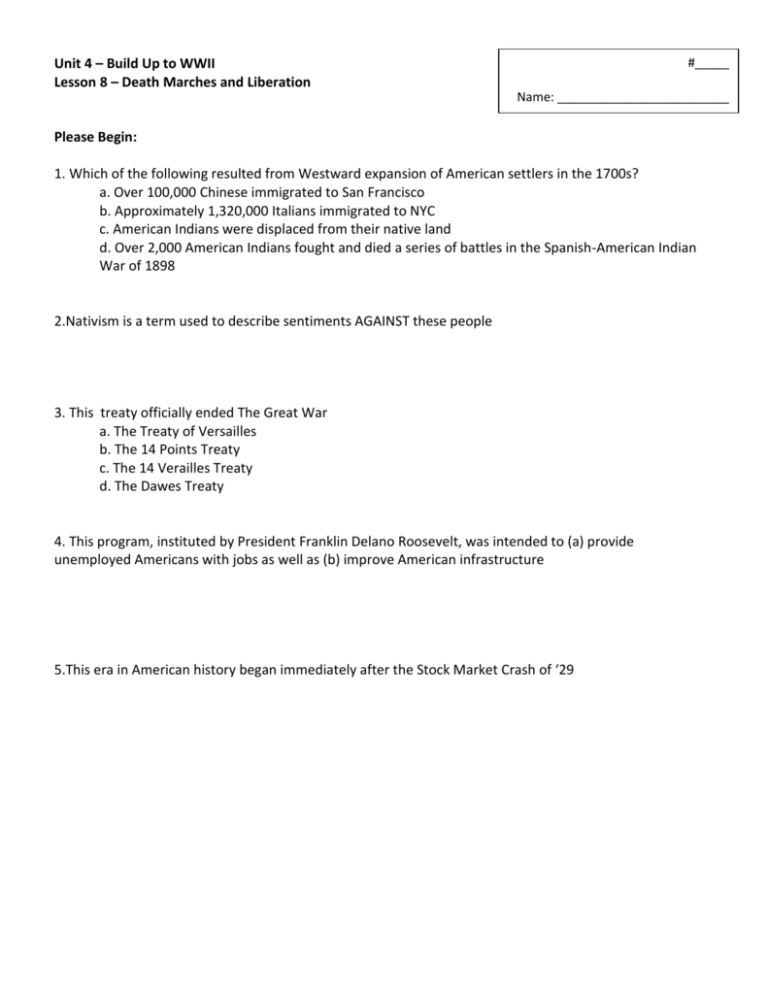
#_____ Unit 4 – Build Up to WWII Lesson 8 – Death Marches and Liberation Name: _________________________ Please Begin: 1. Which of the following resulted from Westward expansion of American settlers in the 1700s? a. Over 100,000 Chinese immigrated to San Francisco b. Approximately 1,320,000 Italians immigrated to NYC c. American Indians were displaced from their native land d. Over 2,000 American Indians fought and died a series of battles in the Spanish-American Indian War of 1898 2.Nativism is a term used to describe sentiments AGAINST these people 3. This treaty officially ended The Great War a. The Treaty of Versailles b. The 14 Points Treaty c. The 14 Verailles Treaty d. The Dawes Treaty 4. This program, instituted by President Franklin Delano Roosevelt, was intended to (a) provide unemployed Americans with jobs as well as (b) improve American infrastructure 5.This era in American history began immediately after the Stock Market Crash of ‘29 Today as we read please take notes as you see fit on the following two topics: Death Marches and Liberation Death Marches A massive Soviet 1944 summer offensive in eastern Belarus allowed Soviet forces to overrun the first of the major Nazi concentration camps, Lublin/Majdanek. Shortly after that offensive, SS chief Heinrich Himmler ordered that prisoners in all concentration camps and sub-camps be evacuated toward the interior of the Reich. Due to the rapid Soviet advance, the German SS had not had time to complete the evacuation of Majdanek. Soviet and western media widely publicized SS atrocities at the camp, using both footage of the camp at liberation and interviews with some of the surviving prisoners. The evacuations of the concentration camps had three purposes: (1) SS authorities did not want prisoners to fall into enemy hands alive to tell their stories to Allied and Soviet liberators (2) the SS thought they needed prisoners to maintain production of armaments wherever possible (3) some SS leaders, including Himmler, believed irrationally that they could use Jewish concentration camp prisoners as hostages to bargain for a separate peace in the west that would guarantee the survival of the Nazi regime. In the summer and early autumn months of 1944, most of the evacuations were carried out by train or, in the case of German positions cut off in the Baltic States, by ship. As winter approached, however, and the Allies reached the German borders and assumed full control of German skies, SS authorities increasingly evacuated concentration camp prisoners from both east and west on foot. By January 1945, the Germany stood on the verge of military defeat. The SS guards had strict orders to kill prisoners who could no longer walk or travel. As evacuations depended increasingly on forced marches and travel by open rail car or small craft in the Baltic Sea in the brutal winter of 1944-1945, the number who died of exhaustion and exposure along the routes increased dramatically. This encouraged an understandable perception among the prisoners that the Germans intended them all to die on the march. The term death march was probably coined by concentration camp prisoners. During these death marches, the SS guards brutally mistreated the prisoners. Following their explicit orders, they shot hundreds of prisoners who collapsed or could not keep pace on the march, or who could no longer disembark from the trains or ships. Thousands of prisoners died of exposure, starvation, and exhaustion. Forced marches were especially common in late 1944 and 1945, as the SS evacuated prisoners to camps deeper within Germany. As Allied forces advanced into the heart of Germany they liberated hundreds of thousands of concentration camp prisoners. This included thousands of prisoners whom Allied and Soviet troops liberated while they marched on the forced evacuations. On April 25, 1945, Soviet forces met U.S. forces at Torgau, on the Elbe River in central Germany. The German armed forces surrendered unconditionally in the west on May 7 and in the east on May 9, 1945. May 8, 1945, was proclaimed Victory in Europe Day (V-E Day). Liberation As Allied troops moved across Europe in a series of offensives against Nazi Germany, they began to encounter tens of thousands of concentration camp prisoners. Many of these prisoners had survived forced marches into the interior of Germany from camps in occupied Poland. These prisoners were suffering from starvation and disease. Soviet forces were the first to approach a major Nazi camp, reaching Majdanek near Lublin, Poland, in July 1944. Surprised by the rapid Soviet advance, the Germans attempted to hide the evidence of mass murder by demolishing the camp. Camp staff set fire to the large crematorium used to burn bodies of murdered prisoners, but in the hasty evacuation the gas chambers were left standing. In the summer of 1944, the Soviets also overran the sites of the Belzec, Sobibor, and Treblinka killing centers. The Germans had dismantled these camps in 1943, after most of the Jews of Poland had already been killed. The Soviets liberated Auschwitz, the largest extermination and concentration camp, in January 1945. The Nazis had forced the majority of Auschwitz prisoners to march westward in “death marches” and Soviet soldiers found only several thousand emaciated prisoners alive when they entered the camp. There was abundant evidence of mass murder in Auschwitz. The retreating Germans had destroyed most of the warehouses in the camp, but in the remaining ones the Soviets found personal belongings of the victims. They discovered, for example, hundreds of thousands of men's suits, more than 800,000 women's outfits, and more than 14,000 pounds of human hair. In the following months, the Soviets liberated additional camps in the Baltic states and in Poland. Shortly before Germany's surrender, Soviet forces liberated the Stutthof, Sachsenhausen, and Ravensbrueck concentration camps. U.S. forces liberated the Buchenwald concentration camp near Weimar, Germany, on April 11, 1945, a few days after the Nazis began evacuating the camp. On the day of liberation, an underground prisoner resistance organization seized control of Buchenwald to prevent atrocities by the retreating camp guards. American forces liberated more than 20,000 prisoners at Buchenwald. British forces liberated concentration camps in northern Germany, including Neuengamme and Bergen-Belsen. They entered the Bergen-Belsen concentration camp, near Celle, in mid-April 1945. Some 60,000 prisoners, most in critical condition because of a typhus epidemic, were found alive. More than 10,000 of them died from the effects of malnutrition or disease within a few weeks of liberation. Liberators confronted unspeakable conditions in the Nazi camps, where piles of corpses lay unburied. Only after the liberation of these camps was the full scope of Nazi horrors exposed to the world. The small percentage of inmates who survived resembled skeletons because of the demands of forced labor and the lack of food, compounded by months and years of maltreatment. Many were so weak that they could hardly move. Disease remained an ever-present danger, and many of the camps had to be burned down to prevent the spread of epidemics. Survivors of the camps faced a long and difficult road to recovery. Was the liberation of concentration camps “too little, too late”? Unit 4 – Build Up to WWII Lesson 8 – Death Marches and Liberation Exit Ticket 1. List 3 effects of the death marches on Jewish prisoners. 2. List 3 effects of the liberation of concentration camps by the Allies. #_____ Name: _________________________ Unit 4 – Build Up to WWII Lesson 8 – Death Marches and Liberation Homework #_____ Name: _________________________ Directions: Tomorrow you will write an essay answering the following question: Could the Holocaust have been prevented? To help clarify your position, answer the following questions: 1. Could the Holocaust have been prevented? Yes or No? 2. If yes, how? If no, why not? 3. Give 2 specific examples that prove your point. 1. 2. 4. What is the counter-argument to your argument? 5. How can you use the counter-argument to your advantage? Directions: Create a thesis statement and 3 assertions that answer the following question: Could the Holocaust have been prevented? Thesis: Assertion #1: Assertion #2: Assertion #3 (Counter-Argument):

